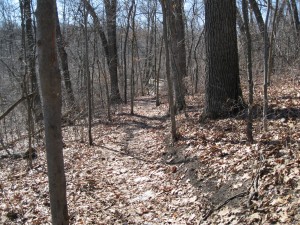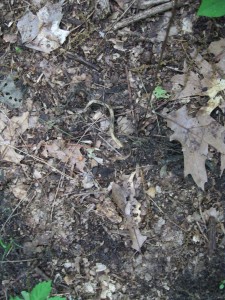Take Action on the Proposed Trail Through the Harvey Ott Biological Preserve

Main esker trail, looking down toward bridge, Harvey Ott Biological Preserve. Photo February 2011 Richard Brewer
The Calhoun County Commissioners will be the ones voting on the trail. They may give more weight to messages from their constituents; nevertheless, it will be of value to them to know if the threat to the Ott Preserve is a matter of concern to conservationists and nature lovers elsewhere.
Most of the information that follows is from the Say “No” to Pavement: Protect Ott Biological Preserve organization and was supplied by Sophia DiPietro. Comments in italics are mine. Besides earlier posts at this website, information on the proposed trail through the preserve and its drawbacks are most readily accessible at the Facebook page Say “No” to Pavement: Protect Ott Biological Preserve, especially the Wall and Info sections.
Upcoming Public Meeting–All are invited.
Ott Biological Preserve Proposed “Trailway” Public Forum Thursday, March 17 (St. Patrick’s Day) 5:30pm – 8:30pm
County Commission Chambers (3rd floor County Building)
315 W. Green St.
Marshall, MI
The County Building is near the center of Marshall . Green is the main east-west street and the county building is half a block east of Kalamazoo Avenue, the main north south Street. (As a landmark, Schuler’s Restaurant is in the next block east on Green.)
This is one meeting you won’t want to miss! Don’t like the thought of the proposed “smooth-surfaced highway” through Ott Biological Preserve? This is YOUR time to speak up. There will be at least one presentation by the trailway alliance promoting their trail, and at least one presentation advocating for the protection of Ott. There will be a question/answer period and hopefully full opportunity for local citizens to make their voices heard against this trail proposal.
Come prepared! Make some notes as to why you feel Ott should remain free from development! County Commissioners need to hear from you! A regularly scheduled County Commission meeting follows the forum at 7pm
The Commission NEEDS to hear your opposition to trail development in Ott Biological Preserve. Send POLITE letters either snail-mail or email (scroll to bottom for emails group).
Calhoun County Board of Commissioners
Julie Camp (Republican)(re-elected)
8934 5 Mile Road
East Leroy, MI 49051
Fax: (269) 781-0140
juliecamp5@gmail.com
Terris Todd (Democrat) (re-elected)
135 Irving Park Dr.
Battle Creek, MI 49017
todd4calhoun@yahoo.com
Jim Haadsma (D) (re-elected)
146 South Lincoln Boulevard
Battle Creek, MI 49015
jhaadsma@mccroskeylaw.com
Mark Behnke (R)
474 Country Club Drive
Battle Creek, MI 49015
mbehnke@behnkeinc.com
Steve Frisbie (R)
148 Pheasantwood Trail
Battle Creek, MI 49017
sjfriz@gmail.com
Blaine VanSickle (R)
16828 21 Mile Road
Marshall, MI 49068
No email
Art Kale (R) (Chair)
3101 Country Club Way
P.O. Box 672
Albion, MI 49224
arthurkale@gmail.com
Compiled email contacts for pasting into email
(NOTE: Commissioner VanSickle does not have an email address):
arthurkale@gmail.com, sjfriz@gmail.com, mbehnke@behnkeinc.com, jhaadsma@mccroskeylaw.com, todd4calhoun@yahoo.com, juliecamp5@gmail.com
For Calhoun County residents, to find out who your specific county commissioner is, check out the county website for more info: www.calhouncountymi.org/Departments/BoardOfCommissioners/OverviewBOC.htm
Parks/Road Commissioners who have pursued this trailway jointly with the nonprofit Calhoun County Trailway Alliance (and therefore may not be objective to concerns):
Christopher Vreeland
119 North Grand Street
Marshall, MI 49068
Fax: (269) 781-6101
Email: cbv@vreelandlaw.com
Scott Brown
504 Lincoln
Albion, MI 49224
Fax: (269) 781-6101
Email: sbrown@calhouncrc.net
Hugh Coward
546 Sylvan Drive
Battle Creek, MI 49017
Fax: (269) 781-6101
Email: local340ironworker@sbcglobal.net
Eric Tobin
520 S. Avenue C
Athens, MI 49011
Fax: None
Email: orionet@aol.com
Email Group:
cbv@vreelandlaw.com, orionet@aol.com, local340ironworker@sbcglobal.net, sbrown@calhouncrc.net















